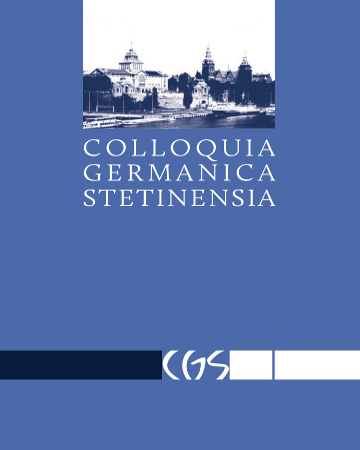







| Authors: |
Aleksandra
Lipińska

Uniwersytet Adama Mickiewicza w Poznaniu, Instytut Lingwistyki Stosowanej |
| Keywords: | crosslinguistic influence language awareness multilingualism |
| Data publikacji całości: | 2023-11 |
| Page range: | 17 (307-323) |
| Downloads ?: | 127 |
| 1. | Aronin, Larissa. „What is multilingualism?“. In: Twelve lectures on multilingualism, hrsg. v. David Singleton, Larissa Aronin, 3–34. Bristol: Multilingual Matters, 2019. |
| 2. | Bardel, Camilla, Ylva Falk. „The L2 status factor and the declarative/procedural distinction“. In: Third language acquisition in adulthood, hrsg. v. Jennifer Cabrelli Amaro, Jason Rothman, 61–78. Amsterdam: John Benjamins, 2012. |
| 3. | Bardel, Camilla, Ylva Falk. „The role of the second language in third language acquisition: The case of Germanic syntax“. Second Language Research 23 (2007): 459–484. |
| 4. | Bloomfield, Leonard. Language. London: Allen & Unwin, 1933. |
| 5. | Butzkamm, Wolfgang. Der Lehrer ist unsere Chance. Essen: Buchverlag Professor A.W. Geisler, 2015. |
| 6. | Cenoz, Jasone, Britta Hufeisen, Ulrike Jessner. Cross-Linguistic Influence in Third Language Acquisition: Psycholinguistic Perspectives. Clevedon: Multilingual Matters, 2001. |
| 7. | Chłopek, Zofia. „Problemy z użyciem przedimków w pisemnej produkcji w języku trzecim: analiza psycholingwistyczna i implikacje glottodydaktyczne“. Lingwistyka Stosowana 10 (2014): 11–23. |
| 8. | Chłopek, Zofia. Nabywanie języków trzecich i kolejnych oraz wielojęzyczność. Aspekty psycholingwistyczne (i inne). Wrocław: Wydawnictwo Uniwersytetu Wrocławskiego, 2011. |
| 9. | De Angelis, Gessica. Third or additional language acquisition. Clevedon, Buffalo, Toronto: Multilingual Matters, 2007. |
| 10. | Festman, Julia. „The Psycholinguistics of Multilingualism“. In: Twelve lectures on multilingualism, hrsg. v. David Singleton, Larissa Aronin, 233–269. Bristol: Multilingual Matters, 2019. |
| 11. | Gemeinsamer Europäischer Referenzrahmen für Sprachen: lernen, lehren, beurteilen. Berlin München: Langenscheidt KG, 2001. |
| 12. | Grosjean, Francois. „An attempt to isolate, and then differentiate, transfer and interference“. International Journal of Bilingualism 16/1 (2001): 1–11. |
| 13. | Grosjean, Francois. „Neurolinguists, beware! The bilingual is not two monolinguals in one person“. Brain and Language 36 (1989): 3–15. |
| 14. | Hufeisen, Britta. „Theoretische Fundierung multiplen Sprachenlernens – Faktorenmodell 2.0.“ Jahrbuch Deutsch als Fremdsprache 36 (2010): 200–208. |
| 15. | Kemp, Charlotte. „Defining multilingualism“. In: The exploration of multilingualism, hrsg. v. Larissa Aronin, Britta Hufeisen, 11–26. Amsterdam: John Benjamins, 2009. |
| 16. | Neuner, Gerhard. „Mehrsprachigkeitskonzept und Tertiärsprachendidaktik“. In: Mehrsprachigkeitskonzept – Tertiärsprachen – Deutsch nach Englisch, hrsg. v. Britta Hufeisen, Gerhard Neuner, 13–34. Strasbourg: Council of Europe Publishing, 2003. |
| 17. | Odlin, Terence. Language Transfer. Cross-linguistic influence in language learning. Cambridge: Cambridge University Press, 1989. |
| 18. | Rothman, Jason. „Cognitive economy, non-redundancy and typological primacy in L3 acquisition“. In: Romance languages and linguistic theory 2011, hrsg. v. Sergio Baauw, Frank Drijkoningen, Luisa Meroni, Manuela Pinto, 217–247. Amsterdam: John Benjamins, 2013. |
| 19. | Rothman, Jason. „Linguistic and cognitive motivations for the typological primacy model (TPM) of third language (L3) transfer: Timing of acquisition and proficiency considered“. Bilingualism: Language and Cognition 18/2 (2015): 179–190. |
| 20. | Rothman, Jason. „L3 syntactic transfer selectivity and typological determinacy: The typological primacy model“. Second Language Research 27 (2011): 107–127. |
| 21. | Singleton, David, Larissa Aronin. Twelve lectures on multilingualism. Bristol: Multilingual Matters, 2019. |
| 22. | Sopata, Aldona. „Dwujęzyczność, trójjęzyczność, wielojęzyczność: podobieństwa i różnice”. In: Scripta manent – res novae, hrsg. v. Stanisław Puppel, Teresa Tomaszkiewicz, 399–408. Poznań: Wydawnictwo Naukowe UAM, 2013. |
| 23. | Steinhauer, Britta. Transfer im Fremdspracherwerb. Frankfurt a. M.: Peter Lang, 2006. |